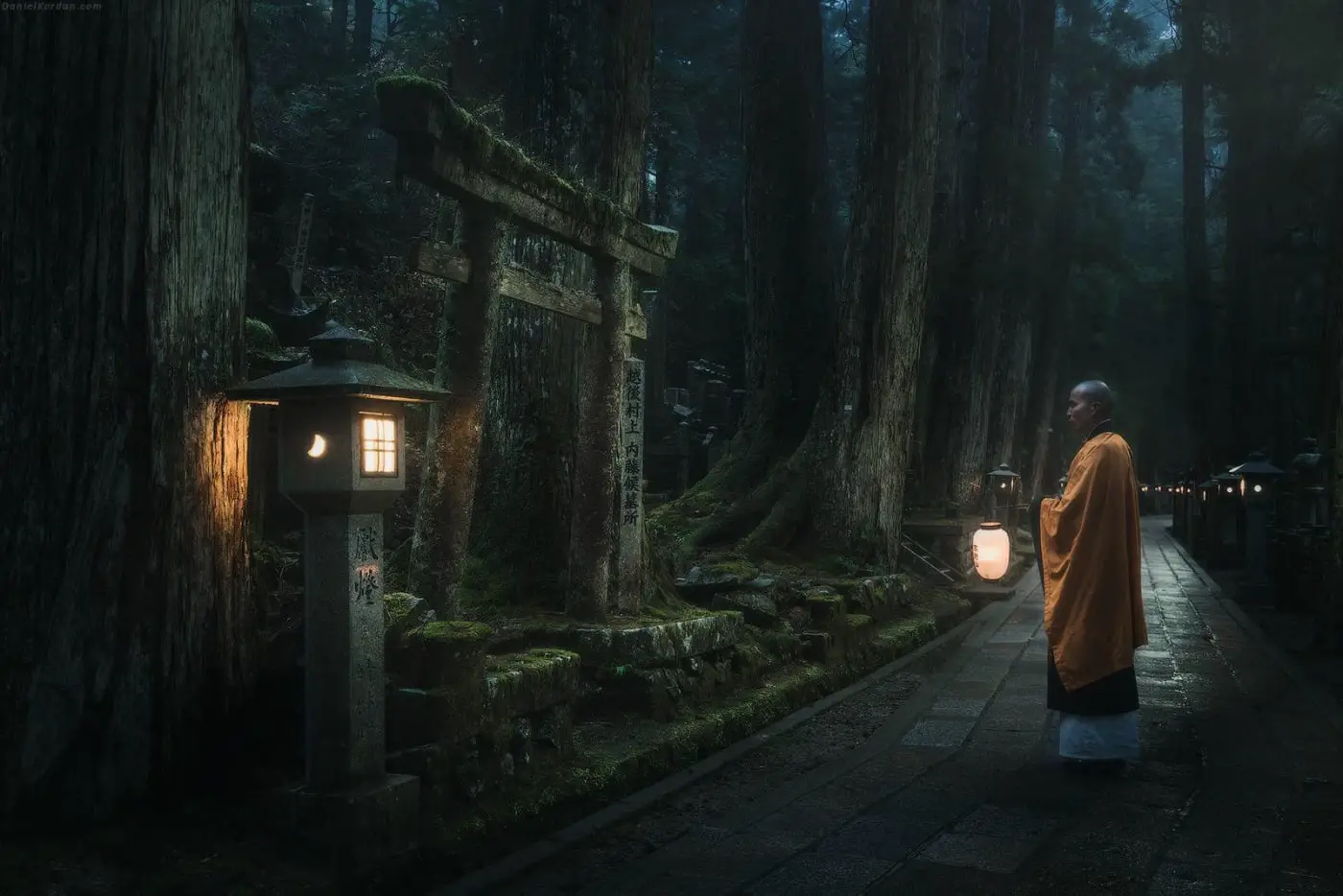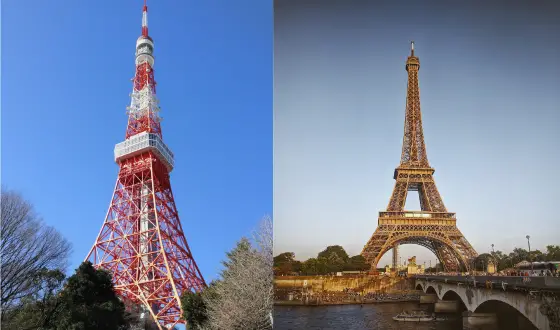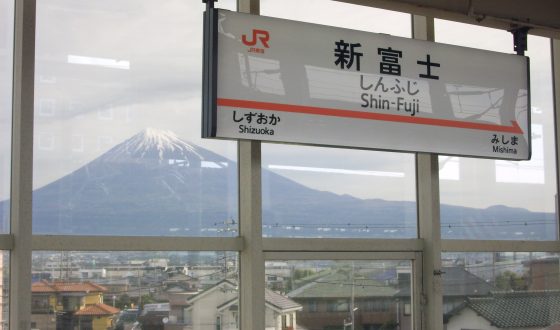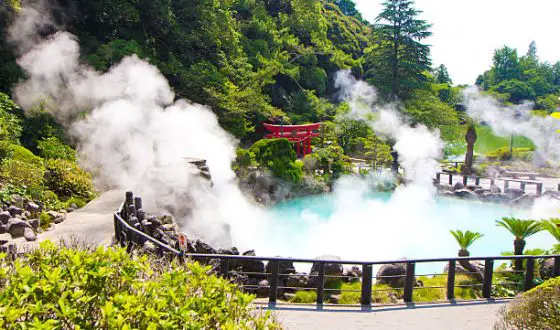The Rise of Dark Tourism In Japan – Top 12 Scariest Destinations
If you watch the recently released Netflix series “Dark Tourist”, you will find a radioactive tour in Fukushima, Japan in episode two, one of the most terrifying experiences on earth. But aside from Fukushima, Japan has much more to offer curious and adventurous dark tourists. In fact, promoting dark tourism is a tragedy from Japan’s Reconstruction Agency to help the post-disaster towns recover or develop the economy in remote local places. So, Japan is definitely a friendly country for international dark tourists. Let’s find out more about dark tourism in Japan and the top 12 scariest must-visit destinations in this article.
What is Dark Tourism?
In the book “Dark Tourism” by Foley and Lennon in 1996, this term refers to the act of traveling to places of post-disaster, death, war atrocity, or any type of tragedy.
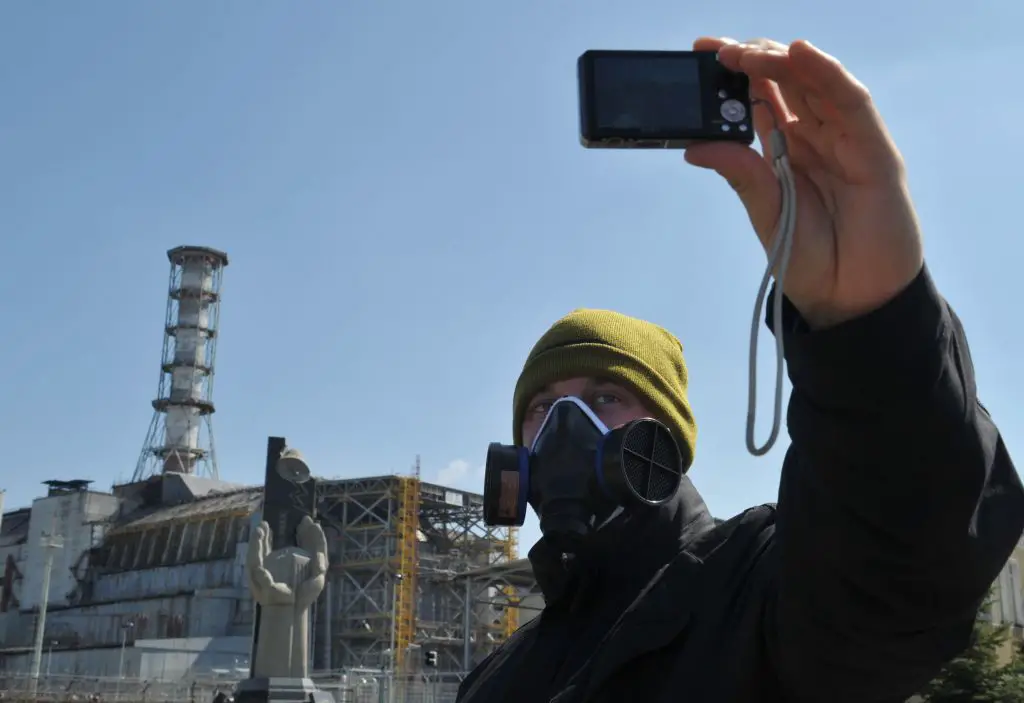
Dark tourism refers to the act of traveling to places of post-disaster, death, war atrocity, or any type of tragedy. (Source: Internet)
SEE MORE:
Indeed, this type of tourism has caused endless controversy from its very first day of existence. Many people criticizing dark tourism state that it is not appropriate to make money from the past trauma. However, when looking on the bright side, we can see dark tourism can serve as a historical class. It reminds humanity of our past mistakes so that we can avoid or at least be prepared if similar disasters happen again. Sometimes, for instance, tragedy in Hiroshima teaches us about the value of peace, resilience, and love shared among people. Besides, it is about time the site itself along with its residents heal from all the trauma and that site may find a chance to be back on the map someday.
The rise of Dark Tourism in Japan
Throughout its rich history, Japan has had its ups and downs many times. It used to suffer from natural disasters such as tsunami or earthquakes to the darkest time associated with World War II including the atomic bombing in Hiroshima and Nagasaki. These events in the past leave us not only important lessons but also dark tourism sites. Furthermore, Japan has its unique culture of many mythologies or dark folklore which provide some spooky forests, tunnels, or other creepy places.

David Farrier traveled to Japan in Netflix series “Dark Tourist”. (Source: Internet)
In the past 20 years, tourism in Japan explodes and the country becomes worldwide famous for its bizarre experience such as anime, robots, festivals. But only in the past few years, due to the digital revolution, as people share their experience on social media, the mass is aware of the dark tourism in Japan. More and more choose to follow this phenomenon rather than other mainstream forms of tourism.
TOP 12 Dark Tourism Destinations in Japan
If you are visiting Japan and also get bored with ordinary activity, you may want to get into the game of dark tourism and discover the 12 most creepy destinations in Japan listed below.
1. Fukushima Exclusion Zone
When it comes to dark tourism in Japan, the first come to anybody mind is a place which has been through it all: earthquakes, tsunami and as a result, nuclear disaster. In fact, earthquakes are not something strange in the country since Japan lies on the crossing zones of many continental and oceanic plates. This is also the reason why Japan has so many active volcanoes and hot springs. Moreover, tsunami or tidal waves are usually caused if earthquakes arise below or near the sea.
At 14:46 on 11 March 2011, the magnitude 9.0–9.1 (Mw) undersea earthquake along with the tsunami struck the north-east coast of Honshu (main island) and is recorded as the worst earthquake in Japan history since the record started in 1900. But none could ever imagine the double natural disaster earthquakes and tsunami is capable of leading to a much worse catastrophe. Fukushima Daiichi Nuclear Power Plant is the first nuclear accident at level 7 ever since Chernobyl. There were approximately 20,000 deaths and massive structural damage.
Fukushima Exclusion Zone Now
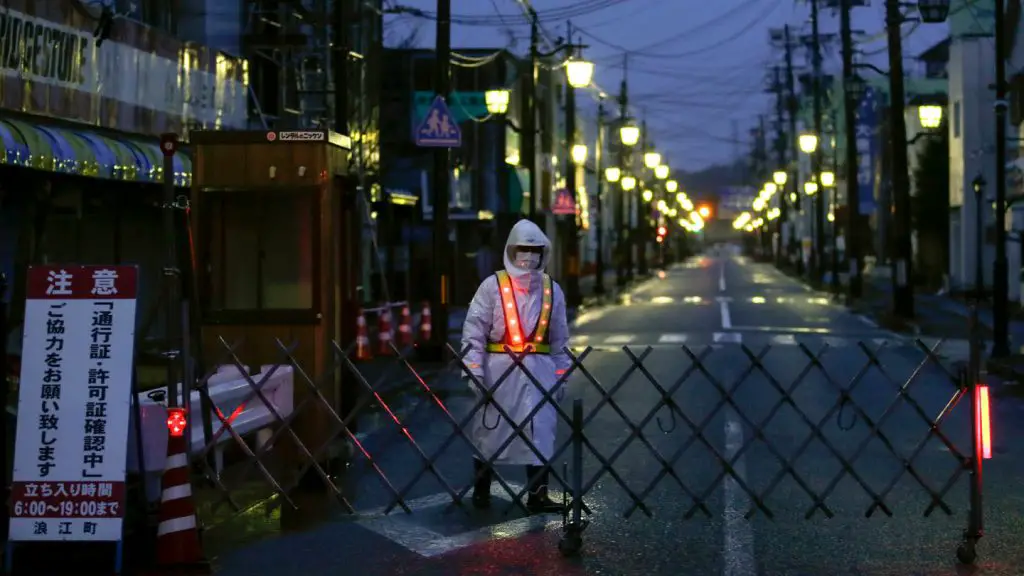
Most of Fukushima is restricted to only journalists and photographers.
Due to the problematic radioactive iodine in the air, soil, and water, residents were evacuated and the area around the power plant has later been forbidden exclusion zone. Only permitted journalists and photographers could enter the ghost towns. As a daring dark tourist, you can still visit one reopened town called Odaka. Odaka is quite close to the station so it is possible to join a 1-day tour from Tokyo to Odaka. Is it dangerous? Not as the Netflix series “Dark Tourist” depicts, it even narrates some wrong information and exaggerates the situation. Keep in mind that Odaka is reopened after successful clean-up efforts. So, come to Fukushima yourself to really know what was and is happening in this place without worrying about any damage to your longevity.
- Location: Odaka, Fukushima, around160 miles (250 km) to the north of Tokyo.
- Access: nearly impossible to travel independently, so pre-arranged tours are recommended
- Costs:¥ 5000/person for a standard guided tour, higher prices for smaller groups, and custom tours. near impossible independently, but made possible through pre-arranged guided tours; not cheap.
See more about this area in the video below:
2. Hiroshima
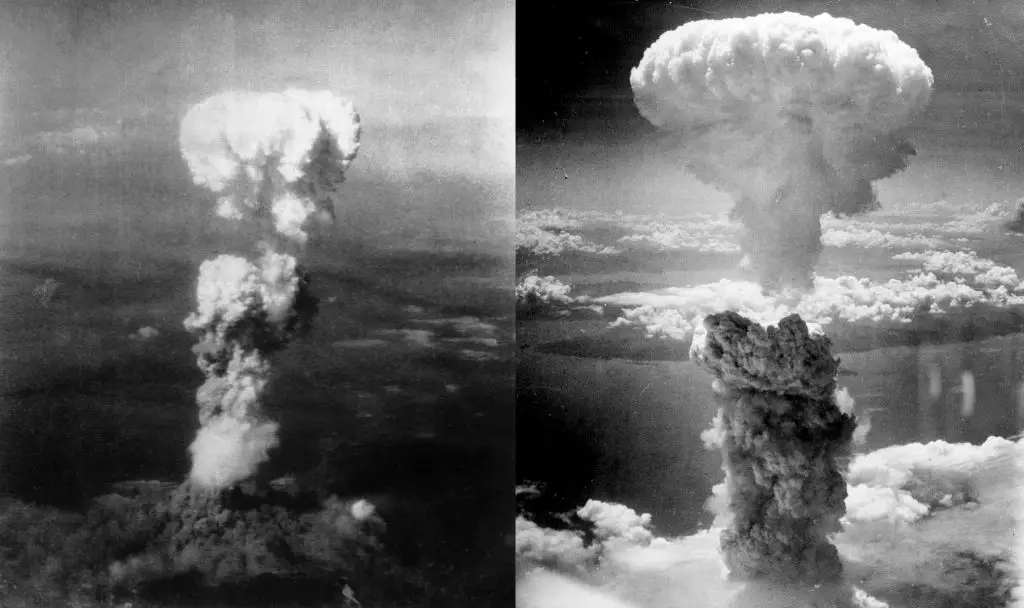
The atomic bomb dropped in Hiroshiman during World War II
Hiroshima and Nagasaki are both victims of the atomic bomb during World War II. However, concerning the atomic bomb, people usually think of the devastating war atrocity in Hiroshima on the 6th of August partly because Hiroshima suffered from much more damages related to loss of lives (almost 140,000 people).
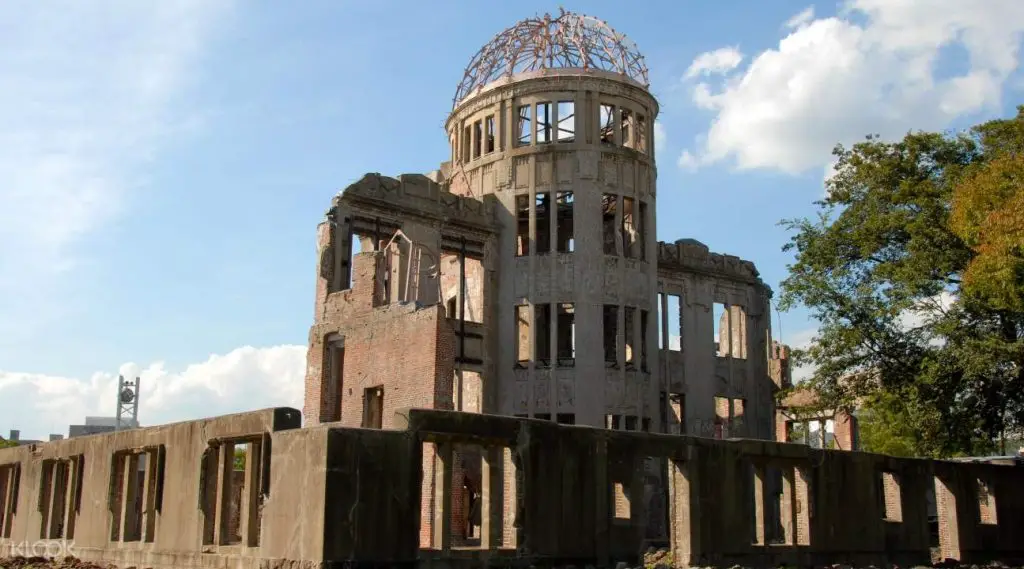
Many consider Hiroshima Atomic Bomb Dome the Eiffel Tower of dark tourism.
There are various sites in Hiroshima that show you the impact of the bomb on this city, but a typical choice for dark tourists is the Peace Memorial or the Atomic Bomb Dome. In fact, it is just the remnant of a Prefectural Industrial Promotion Hall next to hypocenter but fortunately, preserves most of its structure. Many consider Hiroshima Atomic Bomb Dome the Eiffel Tower of dark tourism, so it is definitely a must-visit during your trip to Hiroshima. Another well-known landmark is the Memorial Cathedral for World Peace which is a church constructed to celebrate and spread hope for peace. If you are a new dark tourist, these destinations are a good start since they are not dark or scary, but more like an iconic historical attraction that survived the tragic war along with the first atomic bomb to be dropped.
- Location: in Central Hiroshima, in the north of the Peace Memorial Park
- Access: easy to find
- Costs: free
3. Aokigahara Suicide Forest

There is still actual suicide committed in Aokigahara along with expanding numbers of visitors.
Just like its name, Aokigahara, which means Sea of Trees in Japanese, is known as a place many people have committed suicides. This makes Aokigahara full of dark aura and maybe some remains or dead bodies. The terrifying matter is that there is still actual suicide committed here along with expanding numbers of visitors. Unless you have a strong stomach and a good sense of direction, you should not risk going into this paranormal forest. Even some daring and experienced dark tourist may refuse to come here since witnessing real deaths may be too unethical.
- Location: Minamitsuru District, Yamanashi Prefecture, in the northern foothills of Mt. Fuji
- Access: independent travel or private tour
- Cost: expensive private tour of ¥000/ person
4. Hashima Island – Ghost Town

Hashima or Battleship Island is among the most astounding ghost towns in the world.
This little island is among the most astounding ghost towns in the world. Hashima was home to miners and their families until its underwater coal mine closed in 1974. Ever since, once crowded place like Hashima with all hospitals, schools, houses have been deserted. Only after 40 years, in 2009, visitors can join the boat excursions to Hashima and go sightseeing in this abandoned city.
What makes Hashima attractive to the dark tourists is not the fact that it is out of service but its darkness. During World War II, Harshima was the prison for thousands of Korean and Chinese unwilling laborers who were forced to work and treated inhumanely. Due to this part of Hashima history, it has another Japanese name “Gunkanjima”, which means ‘battleship island.
- Location:12 miles (19 km) to the south-west of Nagasaki
- Access: restricted tour
- Cost: expensive
5. Mt. Aso
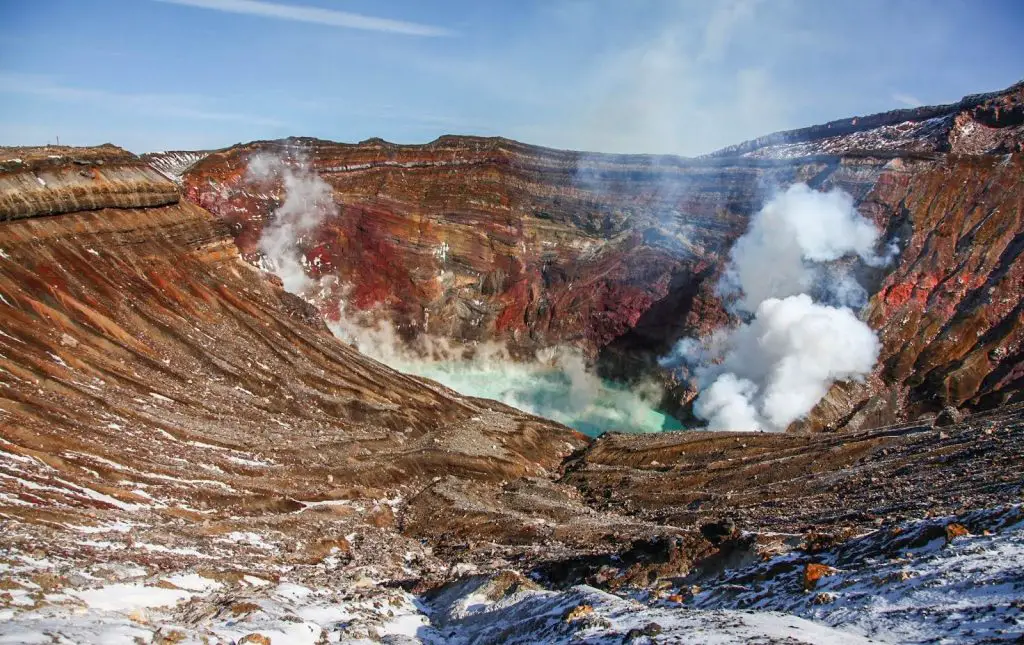
Mountain Aso is among the most active volcanoes in Japan.
Mountain Aso is among the most active volcanoes in Japan and one of the most sizable calderas on earth. So it offers basically quite a magnificent view. Besides, tourists coming to Aso can stay at nearby campsites, go horse-riding and enjoy the view of the crater rim from above in the helicopter. You can only access all these activities as long as the weather, the level of poisonous gar, and the volcanic activity are right.
- Location: 25 miles to the east of Kumamoto, Kyushu
- Access: possible independent travel. There are a car park, shuttles, and walking trails near the mountain. Otherwise, you can take part in a bus tour from Kumamoto or a round-trip packages of Kyushu.
- Costs: A visit to the crater is free but you have to pay ¥ 840 to enter The Volcano Museum (opening from 9 a.m. to 5 p.m., every day. Taking a ropeway or car from the base to crater costs another ¥600 one way, ¥1000 return ticket.
6. Okunoin Cemetery
Situated deep in the forest of Mount Koyasan, Okunoin Cemetery is a perfect destination for someone who likes the eerie silence and religious beauty. In fact, this place is highly sacred as it was where Shingon Buddhism in Japan originated, dating back to more than 1,200 years ago. The cemetery has over 200,000 gravestones along with memorials, including those of Buddhist monks, especially Kobo Dashi, the founder of Shingon Buddhism. Some of the monuments covered with red clothes mean they belong to passed-away children. The parents placing their babies’ tombstones there with the hope to protect them on the way to the afterlife.
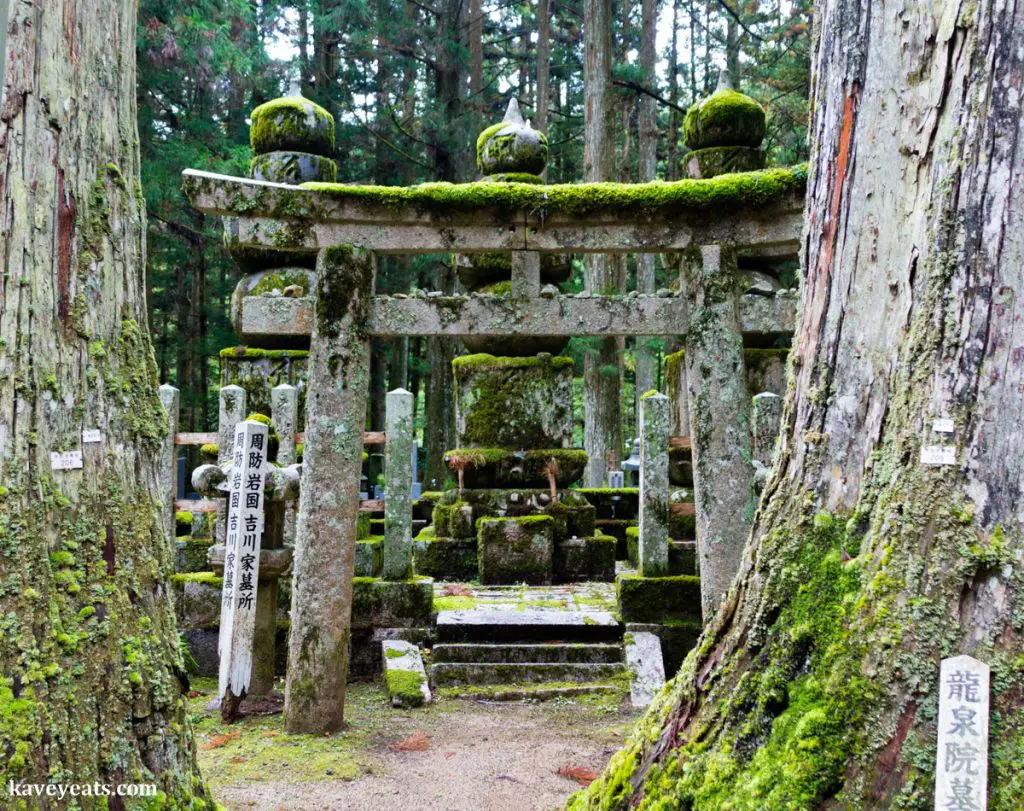
The cemetery has over 200,000 gravestones along with memorials.
For tourists, walking through Okunoin Cemetary during the daytime and visiting The Hall of Lamps at night are impressive and intimate experiences. You can stay close by in a traditional Buddhist Temple such as Yochi-in or Kumagaiji, try some vegetarian dishes and join the prayer service at dawn.
- Location: Koyasan
- Access: mainly independent travel. There is a bus line from the town center Senjuinbashi to Okunoin-mae (final stop) which is within a-minute walk to the Cemetery.
- Cost: Free
7. Old Chusetsu Tunnel – Fukuoka
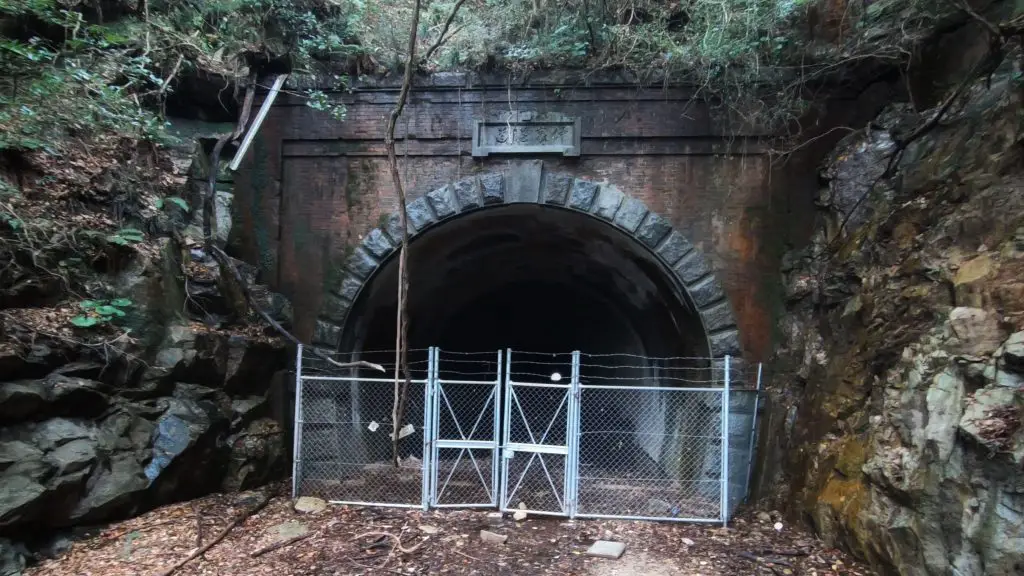
In the creepy Chusetsu Tunnel, actual frightening murders took place.
Out-of-service tunnels are dangerous not only in Japan but anywhere in the world. In this creepy Chusetsu Tunnel, actual frightening murders took place. It is horrifying to just walk past the entrance let alone wandering through it. Some daring travelers have reported about their strange experience inside the tunnels, for example, there are wailing voices warning “stop”. That strange phenomenon attracts the attention of Japanese TV programs so every year there are adventure shows there.
- Location: Hachioji, Tokyo, Fukuoka
- Access: only independent travel
- Cost: free
8. Nara Dreamland
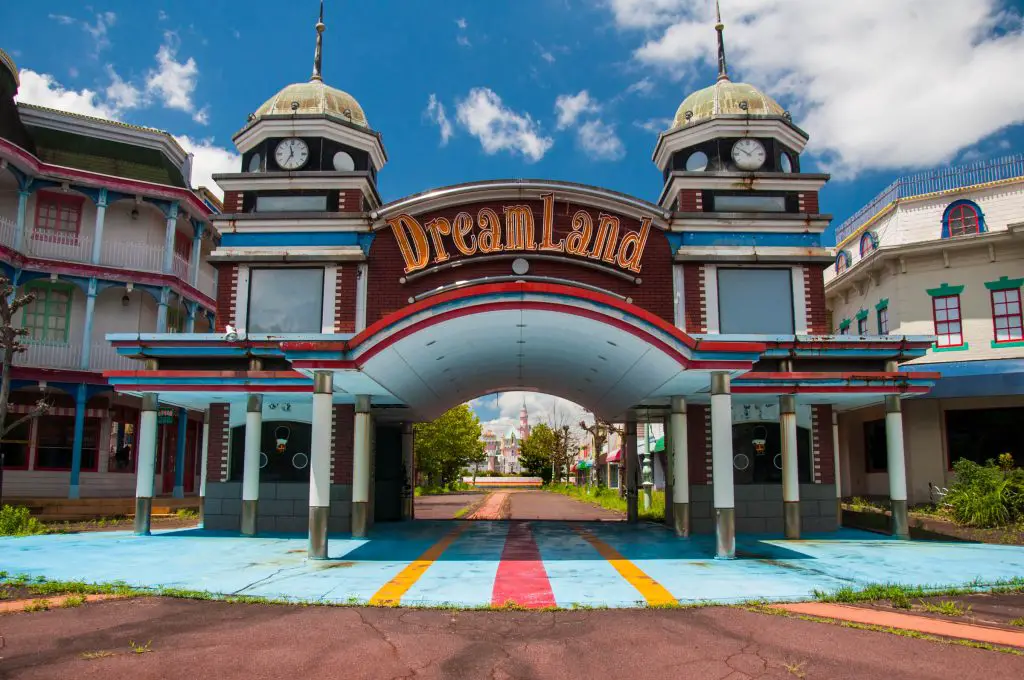
Haikyoists, or urban explorers claim to witness strange happenings in Nara Dreamland.
Constructed in 1961, it used to be the substitute Disneyland theme park in Nara, Japan until the real Tokyo Disneyland opened. Nara Dreamland was quickly out of business in 2006 and soon becomes quite decayed after 15 years. There are overgrown plants, demolished roller coasters, and torn-down animation statues, which are pretty spooky images. Now, it is no place for families and kids, but more like a popular site for haikyoists, or urban explorers who claim to see strange happenings here.
- Location: Nara, Japan
- Access: only independent travel
- Cost: free
9. Okunoshima Rabbit Island
Okunoshima may be more popular for its cute tourism as most of 100,000 visitors to this island every year, come to feed and interact with the rabbits. But the dark secret behind Okunoshima and its huge number of feral rabbits also makes it stand out in the dark tourism in Japan.
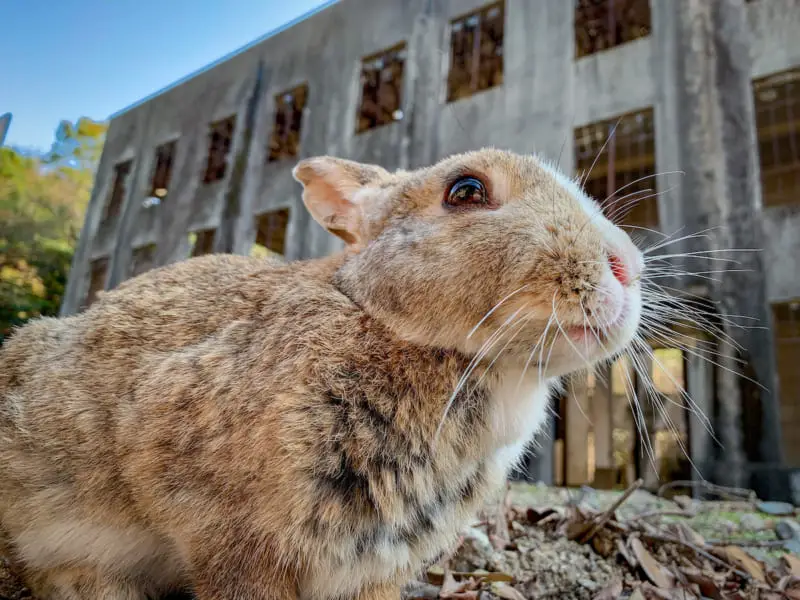
The descendants of the lab rabbits (approximately 10,000 rabbits) are the main residents on this island
From 1929 toward the end of World War II, Okunoshima island hosted many chemical weapons production including mustard gas or cyanic acid. There are rumors that the use of these toxic substances is not only WWII but also the Japanese war against China in which thousands of people died. This cruel production has been only brought to the light since the 1980s when more and more victims started speaking up. Then, the local authority built a Poison Gas Museum and allow a guided tour here. The descendants of the lab rabbits (approximately 10,000 rabbits) are the main residents on this island now. For more information, please visit: http://rabbit-island.info/en/
- Location: 2 miles (3.2 km) off the coast at Tadanoumi in Hiroshima Prefecture
- Access: independent travel or tour, the best way is to catch a 15-minute ferry from Tadanoumi
- Cost: affordable (except hotel price)
10. Meguro Parasitological Museum
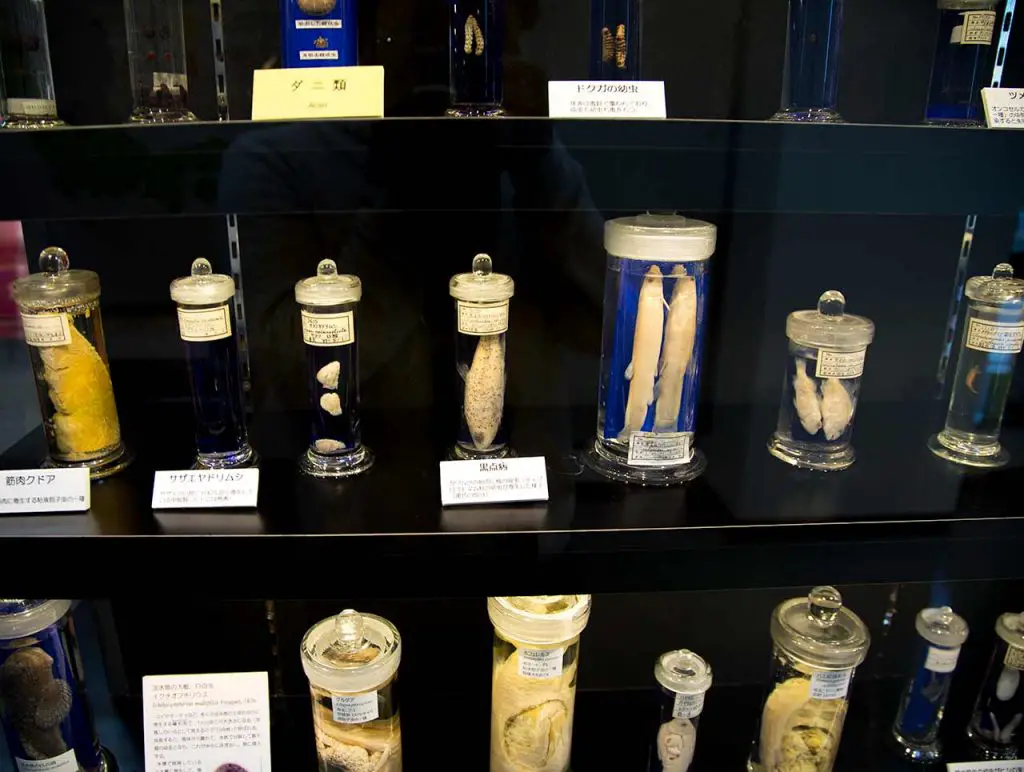
There is a 300-preserved-specimen display in Meguro Museum.
Even if you have a short trip to Tokyo, you can still experience dark tourism in Japan by visiting Meguro Parasitological Museum. It is a medical museum from almost 70 years ago with a devotion to parasitology. In particular, there is a 300-preserved-specimen display and a library that has 5,000 books, as well as 50,000 papers on parasites. Therefore, the museum exhibition proves to be of good educational purpose and a quite itchy visual challenge to some. On the second floor, you can buy some souvenirs such as T-shirts, a guidebook or even a mobile-phone straps with actual parasites embedded. For more information, please visit the official website at https://www.kiseichu.org/e-top
- Location: Meguro Ward, Tokyo, Japan.
- Access:10:00 a.m. to 5:00 p.m from Wednesday to Sunday.
- Cost: Free (Donations are welcome)
11. Ishinomaki
Another place affected tremendously by the 3rd March 2011 earthquake and tsunami (up to 8 meters!), is the seafront district of Ishinomaki. At that time, the flooding hit the city center which caused the destruction of functioning infrastructure. Moreover, broken gas pipes resulted in fires and burning houses. The number of fatalities was 3300 people and that of evacuees was 50,000 people. Regarding money, the damage in Ishinomaki costs over 250 billion yen or 30 billion EUR.
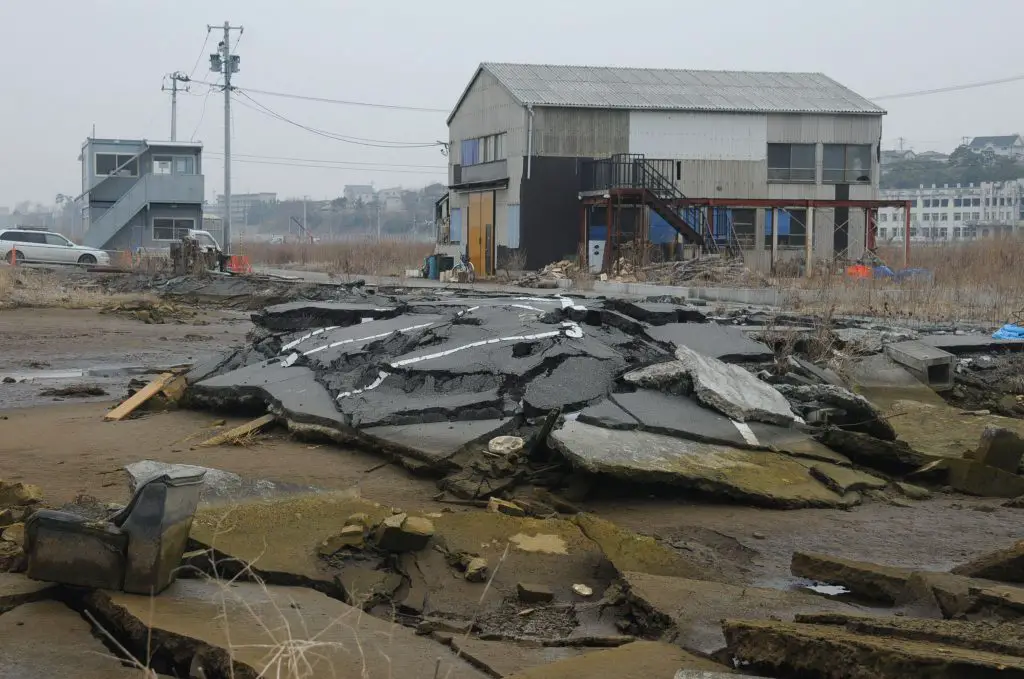
As a foreign visitor, you can access English information and narrative at Ishinomaki.
Compared to other places destroyed by the tsunami in Japan, Ishinomaki may not be the most severe case. However, the documentation along with the tribute to the past here is well organized by the Ishinomaki Community & Info Center (ICIC) which the director is British Therefore, as a foreign visitor, you can be sure that you can access English information and narrative at the place.
- Location: in the north-east of Miyagi Prefecture in northern Honshu, Japan
- Access: easy to find and visit
- Cost: Free
12. Kenji Monument and Cave, Okinawa
The last destination of dark tourism in Japan is the Kenji monument. It serves as a memorial to nearly 400 high school-age boys. These boys had to join the war unwillingly and mostly lost their lives. Kenji cave was where they were trapped by US troops and many suicided instead of being captured according to the urge of the Japanese propaganda. Others couldn’t survive through enemy fire or bombardment.

The cave was where the boys spent their last few days.
Arriving at this place, you can see numerous monuments but the most famous is Kenji-no-To which is the statue of three boys. There is also a tiny memorial usually full of flowers under a huge block of rock. Right nearby is the cave where the boys spent their last few days.
- Location: to the south coast of Okinawa Prefecture, west of Okinawa Peace Memorial Park
Access: quite difficult to find. - Cost: free
CONCLUSION
In a few year’s time, dark tourism in Japan witnesses an incredible rise in popularity. Aside from anime, robots, or festivals, you can visit the rising sun country to enjoy a whole new creepy experience in some spooky locations. In fact, these places (some with English-speaking guided tours) are getting more and more accessible for foreign tourists. One thing to keep in mind is that this list doesn’t aim to draw attention to the bad but would rather focus on the positive effect of dark tourism in terms of educational and economic purposes. All in all, should you have any questions or any story to tell involved with dark tourism in Japan, please feel free to share with us in the comment section.

